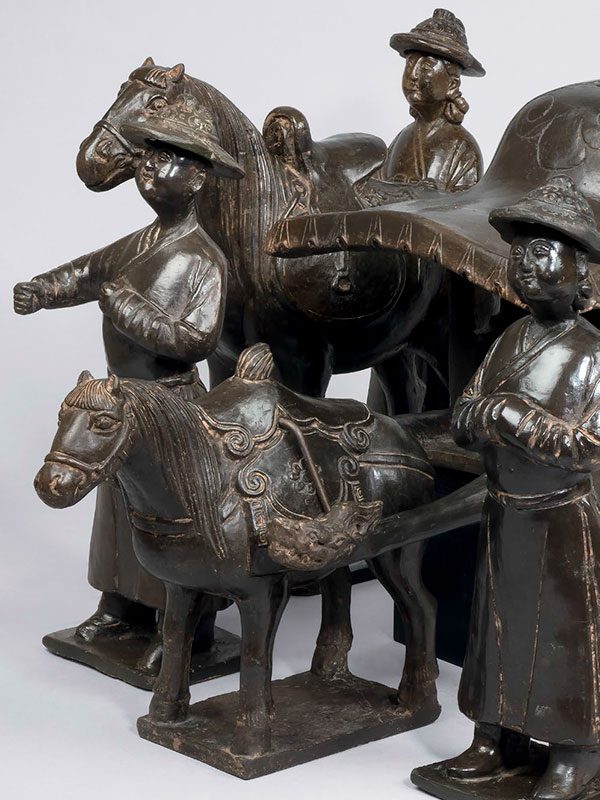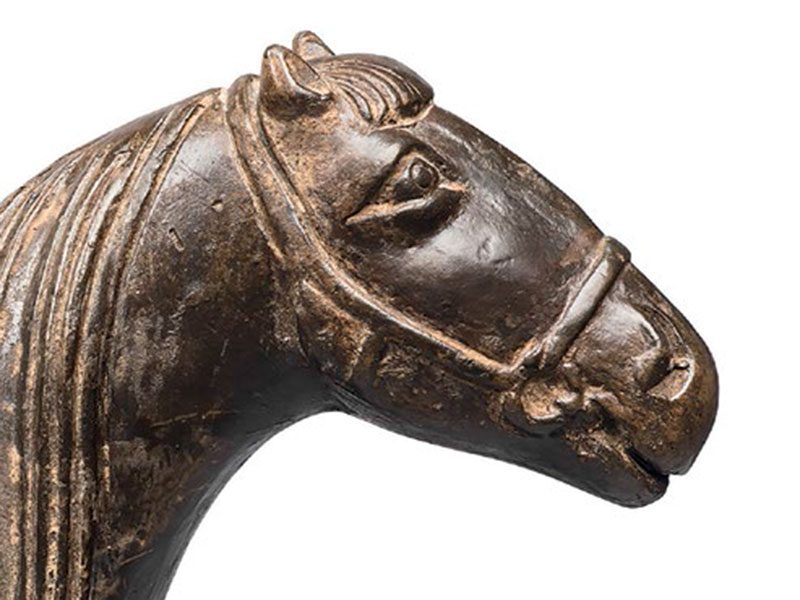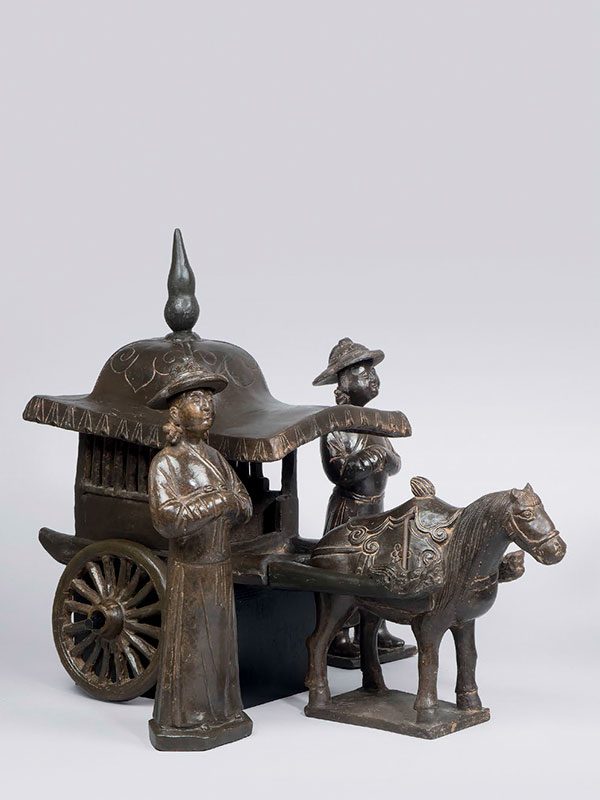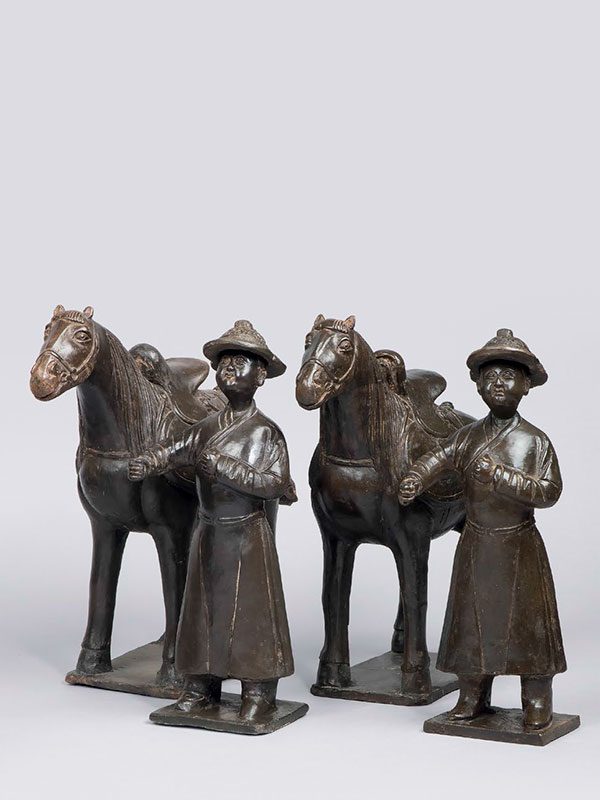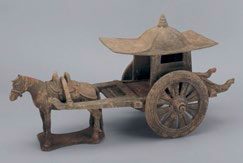Group of black pottery horses, figures and a carriage
A group of black pottery models composed of a carriage, three horses and four figures. The well-modelled two-wheel carriage has a domed roof and slatted sides. It is fitted with two detachable pulling posts, the ends of which are adorned with dragonheads. A tear drop-shaped finial adorns the domed roof. The carriage is pulled by a small horse, equipped with a ceremonial harness. Two larger horses form part of the group and are fully equipped with saddles and bridles. Each horse is depicted in detail with a bushy mane, bulky body and sturdy legs. The figures are depicted standing and dressed in long robes. The two attendants have their hands folded together inside their sleeves, and raise them in front of their chests. The two grooms each have their right hands half raised. The figures are fitted with detachable hats. The pottery is of even black colour and well polished.
This group of black pottery models is a rare Yuan dynasty example. Groups such as this have seldom been studied by scholars. Only a few examples are excavated in Xian city and the Mongol region. The Mongolian people created the Yuan dynasty and established Dadu (the current Beijing) as their capital. They followed traditional Mongolian burial customs instead of Chinese ways. Figures from this period are quite faithful in their reproduction of actual scenes, whether from daily life or from pleasure pursuits. The present figures, probably including merchants and grooms, wear Mongol costumes with a belted tunic over tight trousers tucked into riding boots; all these to help them against the severe cold weather on the Mongolian Plateau. The horses, different from the Tang dynasty ones which were brought to China from the West, were modelled after one of China’s native horses, the Mongolian steppes pony, from the homeland of the Yuan dynasty.[1] Some closely comparable Yuan dynasty pottery horses and figures were excavated in Xian city and are now in the collection of the National Museum of Shaanxi History.[2] Very similar figures of a groom wearing a broad-brimmed hat and of a servant dated to the Yuan dynasty are amongst a group of figures excavated from the He family tomb in Hu County, Shaanxi province in 1978.[3] A large group of pottery models, including horses, figures, a carriage and other utensils, is in the collection of the China Agricultural Museum, Beijing (fig. 1).[4] Four comparable pottery horses with grooms are illustrated in Horses for Eternity.[5]
- Choan toyo no seika – Selected pottery treasures from Xi’an, Miho Museum, Shigaraki-cho, 2004, p. 165
- Ibid, nos. 75, 76, 78, pp. 105, 106, 108
- Caroselli, S. (ed) The Quest for Eternity, Chinese Ceramic Sculptures from the People’s Republic of China, Los Angeles County Museum of Art, Thames & Hudson, 1987 nos. 97-8 and no. 101, p. 150-1
- Yin, Qing, ‘Tao zhong gui bao- Zhong guo nong ye bow u guan yuan dai he tao jian shang (Pottery treasure – Yuan dynasty black potteries in the collection of the China Agricultural Museum), in Identification and Appreciation to Cultural Relics, 2004 (11), figs. 1-6
- Choi, V., Horses for Eternity – Terracotta Equestrian Tomb Sculpture of Dynastic China, Dragon Culture Ltd., Hong Kong, 2007, nos. 154 & 155, pp. 330, 332
黑陶馬車群俑
元 1279 – 1368
高(馬車):40.5公分
黑釉陶俑一組,包含馬車一組,三匹馬,二牽馬伕與二隨從。馬車是由車輿與一對車輪組成,配以一
小型馱馬。馬車似轎,拱頂突緣,頂飾一突尖,欄狀窗,車轅前端飾以龍首,轅中立小型馬,配以儀
式用鞍具,裝飾華麗。另外兩匹大型馬則各配一牽馬伕,右手上舉,二侍從則垂拱站立。人物俑均著
長袍馬褂,戴拱型寬沿帽。中國燒製黑陶歷史可溯致史前龍山文化,素面磨光,簡約樸雅。元時馬匹
與唐代由西域進口之馬匹不同,身形矮壯結實,多為蒙古原生馬種。元代由北方遊牧民族建立,馬與
馬車為貴族日常生活所需,高級墓葬常以此陪葬,然出土量極少,近年來只有陝西與內蒙地區有少量
出土。中國農業博物館與陝西歷史博物館均有類似黑陶車馬俑群收藏。
來源:英國私人收藏

